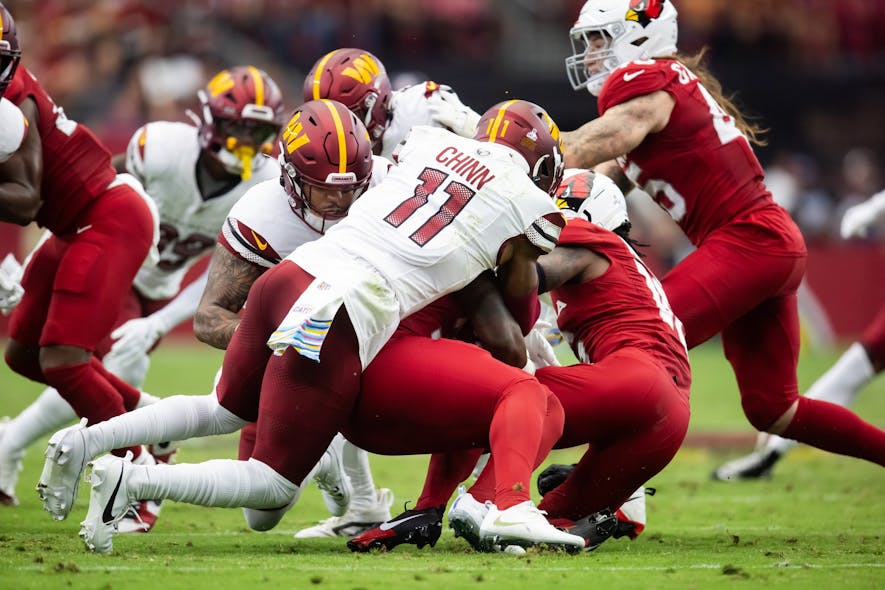Reading the Defense is a weekly column that contemplates the effects of player deployment and schematic trends on individual defensive players' fantasy value. While analytics take hold in NFL front offices and sidelines, data-driven decision-making also benefits fantasy gamers.
Setting Line-Ups by Strength of Schedule
Week 6's edition of Reading the Defense offered roster management strategy for disappointing linebackers. Central to the solution is Footballguys' Strength of Schedule Tool. With it, fantasy gamers can identify favorable match-ups for their linebackers.
The tool reports the number of fantasy points per game that each team has given up against that position compared to the number of points per game that team's opponents have scored in their other games. The range is remarkable. The Vikings are “allowing” opposing linebackers to score 7.9 more fantasy points per game than those same linebackers have scored against other opponents. Linebackers are scoring 5.8 points per game fewer versus the Falcons than they have in other games. A weekly average of 13.7 fantasy points (7.9 plus 5.8) is LB1 territory.
Fantasy gamers should avoid Tampa Bay's K.J. Britt as he hosts the Falcons on Sunday. Linebackers facing the Chiefs, Titans, and Dolphins in positive strength-of-schedule match-ups are likelier to finish as fantasy LB1s for the week.
The same approach will lead fantasy gamers to useful defensive back options. The pass-happy Seahawks are pushing more production to cornerbacks than any other team. The Rams, Cowboys, and Falcons are supplying opposing safeties with 4.5 or more fantasy points per game than those same safeties score against other opponents. The Chiefs, who notoriously cannot push the ball downfield this season, are the league's worst match-up for opposing safeties.
Safety Deployment Still Matters
Off-ball linebacker duos and safety duos have each become more interchangeable in the NFL. Eight years ago, Kwon Alexander led the league in solo tackles as the protected linebacker behind Tampa Bay's over front. While Lavonte David shed the guard on the weak side, Alexander was freer to roam behind a defensive tackle eating blocks.
In that same year, 2016, each of the top ten safeties in fantasy points played a significantly higher share of his snaps in the box than his deep counterpart. Pro Football Focus tracked and recorded the alignment of each snap by snap. Safeties who frequent the second level of the defense have demonstrably higher tackle efficiencies than centerfielders.
In 2024, most primary linebackers rotate through the middle and weak-side roles enough that their tackling efficiencies are similar. New Orleans is an outlier. Long-time coverage maven Demario Davis often patrols deeper than his running mate taking the flats.
Player interchangeability makes defenses harder to attack. Nowhere has this been more evident than at safety. The box safety is a vanishing breed. Teams that routinely play a single high safety with a second safety in the box routinely disguise coverages. Other teams have come to deploy two high safeties much more frequently.
No safety faced more targets in coverage last year than Camryn Bynum. The Vikings have transitioned to a two-high defense in 2024. Bynum is aligning deep for a higher percentage of his reps, according to Pro Football Focus. He is facing an average depth of target of 9.5 so far this season year versus 8.0 last year as reported by Pro Football Reference.
Jahmyr Gibbs put the MOVES on Camryn Bynum during this 45-yard touchdown run ??
— The Athletic NFL (@TheAthleticNFL) October 20, 2024
? @NFL pic.twitter.com/CrwmT7xgT7
Also reported by Pro Football Focus, his average depth of tackle in run defense has increased from 6.8 to 8.3 yards deep. Bynum is 1.6 fantasy points off his 2023 per-game pace in Footballguys' scoring. He averaged eight combined tackles per game last year but just six so far in 2024.
The frequency with which many defenses disguise coverage makes divergent safety roles more difficult to spot using PFF alignment data. PFF's average depth of tackle in run defense (AVDT) and PFR's defensive average depth of target (DADOT) confirm minor differences in deployment.
Offseason indications were that Chicago would use Jaquan Brisker and free-agent addition Kevin Byard III interchangeably this season. Byard has played 74 snaps in the box, according to PFF. Brisker, albeit in one fewer appearance, has played 105 snaps in the box. Brisker's DADOT is more than two yards shallower than Byard's at 9.8. More importantly, Brisker's AVDT is just 3.9 yards beyond the line of scrimmage. Byard is making tackles in run defense almost 10 yards downfield.
The Bears disguise coverage 29.6 percent of the time. In Chicago, this usually involves showing two high safeties (Byard and Brisker) and rotating one safety down at the snap. Few teams play more Cover-3 than Chicago, so Brisker often plays shallow.
Brisker is at risk of sliding down the Footballguys leaderboard due to injury; however, fantasy gamers should not lose faith in him. Moreover, gamers should not hesitate to plug him into their line-ups regardless of opponent.
Jaquan Brisker vs Rams in week 4:
— LandonTengwall (@landon_tengwall) October 2, 2024
-12 Tackles
-1 Sack
-2 TFLs
-1 INT
Brisker is making a strong case for the best Safety in the NFL
pic.twitter.com/pvHc41vARI
Continue reading this content with a ELITE subscription.
An ELITE subscription is required to access content for IDP (individual defensive players) leagues. If this league is not a IDP (individual defensive players) league, you can edit your leagues here.

